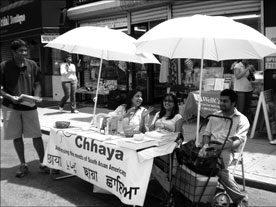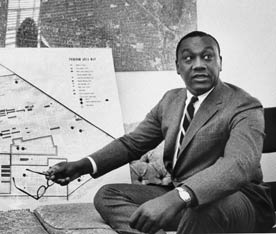Not long after the attack on the World Trade Center in 2001, Afreen Alam noticed some changes in her Jackson Heights, N.Y., neighborhood. The South Asian residents who had routinely walked the streets rarely ventured out of their homes anymore. Neighbors moved away without warning. She even heard stories about young men disappearing. “There was an intimidation factor after 9/11, [particularly] for visibly practicing Muslims,” says Alam. “People didn’t know where to go. They didn’t know their rights.”
It was around this time that Alam heard of an organization that was helping residents who suffered economic losses as a result of the terrorist attacks. Chhaya Community Development Corporation was conducting a major campaign to inform the community about federal aid available from the Federal Emergency Management Agency (FEMA). “A lot of businesses went under after 9/11,” says Chhaya founder and executive director Seema Agnani. “Staff weren’t around; people weren’t going out and buying…. We tried to help people access federal assistance for business interruption suffered in the aftermath.”
A disproportionate number of the cabdrivers, restaurant workers, street vendors, and other laborers who worked in that area of downtown Manhattan were South Asian, mainly immigrants from India, Bangladesh, Pakistan, and Caribbean nations such as Guyana and Trinidad. Many lost jobs, and even their businesses; yet few were seeking help. The lack of knowledge and information about available assistance was certainly a factor, but it wasn’t the only one.
“The discrimination was there…. [It was] an atmosphere of distrust and fear,” says Agnani. “Kids were beaten up. Women and girls were being harassed if they were wearing a hijab.” The rising anti-immigrant sentiment, specifically against South Asians, as well as the language barrier, deterred community members from seeking assistance through mainstream channels such as government agencies, social service providers, and charitable organizations.
In an effort to educate the community, Chhaya published advertisements in local ethnic-language newspapers and handed out flyers in South Asian commercial districts. Its multilingual staff helped people with limited English skills fill out applications for assistance and track the status of their files. As a result, families with little or no resources received money, food, shelter, and clothing to help them get back on their feet.
Chhaya’s ability to meet the urgent needs of the marginalized South Asian community exemplifies a significant change in the community organizing movement: the rise of ethnic-based, or culturally defined, community development corporations.
Changes in Traditional CDCs
Ethnic-based CDCs, or EBCDCs, are different from other community development corporations in several ways. The most obvious difference is how each defines the community it serves. EBCDCs have a much broader definition of community, choosing to serve immigrants of a specific national or ancestral origin, rather than by a geographical neighborhood. Traditionally, a CDC represents the community in which it was first formed. Many groups started with leaders and activists organizing and empowering neighbors, which naturally led to a focus on neighborhoods.
Another difference is in the makeup of organizational leadership. Leaders of typical CDCs don’t often come from the communities where they work. The leaders and staff of EBCDCs are usually immigrants themselves, often first- or second-generation immigrants who are familiar with the cultural barriers and have found ways to overcome them. In a sense, they become an intermediary between the immigrant world and the new world. Many have been educated or trained in fields such as planning, policy, social work, and law, and are familiar with the American system.
Having lived in an immigrant household, many leaders experienced first-hand the difficulties facing immigrants in a new land and have learned from their own struggles and those of their parents. Christopher Kui, executive director of the New York-based Asian Americans For Equality (AAFE), says, “Many of us were immigrants, too, so we shared the aspirations of the community. We knew what programs to develop in order to help people get access to the best of mainstream society.”
The place-based definition was unmistakably reinforced by the choice of the organization’s name, a trend that can be traced back to the inception of the community development movement when Robert F. Kennedy toured the Bedford-Stuyvesant neighborhood of New York. The Bedford-Stuyvesant Restoration Corporation emerged in 1967 as one of the first CDCs in the country. A precedent was established that would be followed by more than 3,000 organizations over the next 40 years.
From Place-Based to People-Based
Although neighborhoods were commonly used to identify the client base represented by most CDCs, cultural changes began to emerge that prompted organizers to explore other avenues of community building — growing acceptance of and identification with ancestral or cultural roots; increasing numbers, visibility, and diversity of immigrants moving to the United States, especially to urban centers; and first- and second-generation immigrants becoming actively involved in the social-justice movement.






Comments